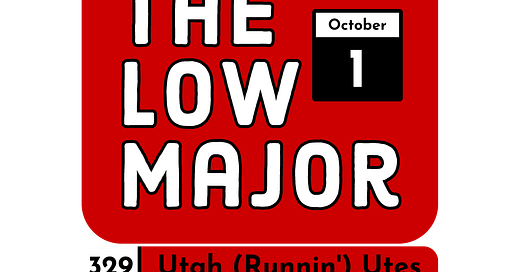Chosen in: 1972 (“Runnin’” dates back to the 1960s)
Chosen by: University administration (“Runnin’” came from local sportswriters)
The University of Deseret was established in Salt Lake City in 1850, at first named after the provisional State of Deseret that the Church of Jesus Christ of Latter Day Saints originally intended to cover most of the American Southwest. Despite this campaign being snuffed out by the end of the 1850s, the school kept “Deseret” in its title until 1892, when they finally renamed it after the Utah Territory that would become the State of Utah four years later.
The University of Utah began playing intercollegiate sports in 1892, when their football team first took the field. Originally, their teams were referred to either by their crimson school color or as the Utahns. In the early 1920s, local sportswriters began replacing these nicknames with Native American monikers. Some called them the Utes, after the most prominent local tribe; others called them a well known Native American slur that I will not print. Perhaps unrelatedly, a few others called them the Red Devils.
Though the two explicitly Native American nicknames were used more or less interchangeably, the slur was the nickname that grabbed the biggest foothold. The university is quick to note that the term was not always viewed derogatorily at the time, but over the decades that followed, it was seemingly universally used in a derogatory manner. It feels pointless to get into specifics.1
This continued until the late 1960s. In 1969, law professor George S. Grossman, inspired by the recent nationwide civil rights movement, sternly requested that university president James C. Fletcher change the school’s athletics nickname to something that didn’t mock Native Americans. Fletcher declined, noting that “to change the name of our athletic squads would take a very great effort”. Then, in January 1970, Grossman asked that the university bookstore at least stop selling merchandise that mocked Native American. To their credit, they did.
April 1970 saw eight Native American students take the mantle from Grossman and campaign for the elimination of Native American athletics nicknames themselves. This got athletics director Bud Jack to remove Native American imagery from all sports materials, but the nickname was still up to university administration. And in case you were wondering whether President Fletcher’s earlier denial was truly out of his claimed laziness or instead out of malice, he called Grossman’s continued requests for his employer to show basic human decency “pestiness”.
It was that “pestiness”, though—from both Grossman and Native American students—that got the university to finally truly consider making a change. At some point in 1970-71, a group of Native American students stormed President Fletcher’s office, again demanding a nickname change. Fletcher finally relented and met with local tribal leaders in May 1971.
After a few of these meetings, the path forward was clear. Local Native American tribes were indeed offended by the use of imagery that caricatured them and their culture, and they resented Utah’s sports teams playing with a slur for a nickname, but they were willing to support the “Utes” nickname as long as it was used in a dignified fashion. The university made an announcement to this effect in 1972, officially dropping the slur nickname and officializing “Utes”.
Following this shift, Utah cycled through a few different Native American mascots and symbols that attempted to be more dignified but were eventually scrapped because they continued to cause controversy. Again, it feels pointless to get into specifics.2 It all led to the 1996 adoption of Swoop, the costumed Red-tailed Hawk that still represents the university today, so chosen because the bird is indigenous to Utah.
Because the “Utes” nickname has been sanctioned by local Native American tribes since 1972, Utah was granted an exemption from the NCAA’s 2005 decision to ban unsanctioned Native American nicknames, imagery, and mascots. Some light dissent over the nickname and its associated symbols has continued to the present day, but that’s all it is; the nickname itself remains widely supported, so nothing appears primed to fundamentally change.
On an unrelated but equally important note…why are they Runnin’? That one dates back to the 1960s, when Hall-of-Famer3 Jack Gardner was coaching the men’s basketball team. His teams, which reached the Final Four in both 1961 and 1966,4 played at such a fast pace that many local sportswriters alliteratively called them the “Runnin’ <slur>s”.
Unofficially, the “Runnin’” epithet stood (for men’s basketball only) even after Gardner left the team in 1971 and the slur nickname was abolished in 1972, thereby removing the alliteration. According to KenPom, Utah men’s basketball has consistently played at a below-average pace since the Rick Majerus era of the 1990s, at some points ranking among the slowest teams in the entire nation. They’re still the Runnin’ Utes.
Previous page: UT Martin Skyhawks
Next page: Utah State Aggies
Find every page at the Name-a-Day Calendar hub!
P.S. Utah’s women’s gymnastics team is known as the Red Rocks. This dates back to a 1993 promotional campaign that debuted the nickname in favor of the incumbent “Lady Utes”. The nickname plays off two things: 1) the red rock formations in southern Utah, and 2) the rock-solid muscles of the gymnasts.
I’ll let the university do it for me. That piece tells this tale more completely. I’m cutting and condensing quite a few details for time and readability.
The piece in footnote 1 does this for me too.
Naismith and College Basketball
Remember that these tournaments had 24 and 22 teams, respectively. Utah only had to win two games in each to reach the Final Four. Whether that’s less or more impressive is up to you.






At least they changed it before they had to.